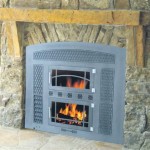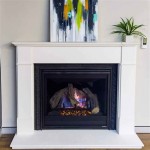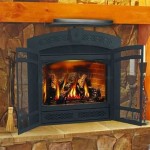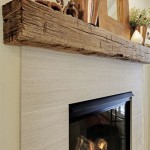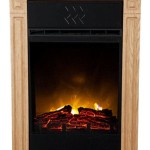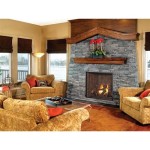Understanding and Installing a Heatilator Fireplace Fan Kit
Heatilator is a well-known brand in the fireplace industry, recognized for its efficient and aesthetically pleasing fireplace designs. A Heatilator fireplace provides warmth and ambiance to a living space. To further enhance the heating capabilities of a Heatilator fireplace, a fireplace fan kit is often employed. This article delves into the functionality, benefits, installation process, and maintenance aspects of a Heatilator fireplace fan kit.
A Heatilator fireplace fan kit is a specially designed accessory that mounts within the firebox or below the fireplace, depending on the model. Its primary purpose is to circulate warm air produced by the fire more effectively into the surrounding room. Without a fan, much of the heat generated by the fireplace rises naturally towards the ceiling and can be lost through the chimney. The fan kit helps to push this warm air outwards, distributing it more evenly throughout the room, thereby increasing the fireplace's overall heating efficiency.
The fan kits are typically powered by electricity and engineered to operate quietly. They are often equipped with a variable speed control, allowing the user to adjust the airflow according to their heating needs and preferences. Different models exist to suit various Heatilator fireplace sizes and designs, so it is crucial to select the correct kit for a specific fireplace model.
Key Benefits of a Heatilator Fireplace Fan Kit
Investing in a Heatilator fireplace fan kit brings several advantages to homeowners looking to maximize the utility of their fireplace. These benefits extend beyond simply increasing the amount of heat distributed by the unit.
Improved Heating Efficiency: The most significant benefit of a fan kit is its ability to improve heating efficiency. By circulating warm air more effectively, the fan reduces the amount of heat that escapes through the chimney and instead directs it into the room. This leads to a more consistent and comfortable temperature throughout the living space. The fan ensures that the heat output is not limited to the immediate vicinity of the fireplace.
Reduced Heating Costs: Due to the improved heating efficiency, a fireplace fan kit can potentially lower overall heating costs. If the fireplace is being used as a primary or supplementary heating source, the fan's ability to distribute heat more effectively can reduce the reliance on a central heating system. This can lead to savings on energy bills, especially during colder months. The degree of savings depends on factors such as the frequency of fireplace use, the size of the room, and the efficiency of the existing heating system.
Enhanced Comfort: A fan kit contributes to enhanced comfort by eliminating cold spots in the room. Without the fan, the area closest to the fireplace may be excessively warm, while other parts of the room remain cold. By circulating the warm air, the fan helps to create a more uniform temperature distribution, making the entire room feel more comfortable and inviting. This is particularly beneficial in larger rooms or open-concept living spaces.
Quieter Operation (in some models): Modern Heatilator fireplace fan kits are often designed for quiet operation. This is an important consideration, as a noisy fan can be distracting and detract from the ambiance of the fireplace. Many kits incorporate features such as vibration dampening materials and low-noise fan blades to minimize noise levels. However, it is essential to research the noise level of different fan kits before making a purchase.
Extended Fireplace Lifespan (indirectly): By promoting better heat distribution and reducing the risk of overheating in certain areas of the fireplace, a fan kit can indirectly contribute to a longer fireplace lifespan. Excessive heat can cause stress on fireplace components, potentially leading to premature wear and tear. The even distribution of heat facilitated by the fan can help to mitigate this risk.
Installation Process of a Heatilator Fireplace Fan Kit
The installation process for a Heatilator fireplace fan kit can vary depending on the specific model and design of the fireplace. However, some general steps and precautions apply to most installations. It is crucial to consult the manufacturer's instructions that accompany the fan kit for specific guidance tailored to the particular model. Prior to commencing the installation, ensure the fireplace is completely cool and that the power supply is disconnected.
Gathering Necessary Tools and Materials: Before starting the installation, gather all the necessary tools and materials. These typically include a screwdriver (Phillips and flathead), wire connectors, wire stripper, pliers, a drill (if required for mounting), and safety glasses. Ensure you have the correct size and type of wire connectors for the electrical connections. It is also beneficial to have a work light available to provide adequate visibility within the firebox.
Locating the Fan Mounting Position: The fan kit's instructions will specify the location where the fan should be mounted. This is typically either within the firebox itself, often near the bottom, or in a cavity below the fireplace. Ensure that the mounting location is clear of any obstructions and that there is sufficient space for the fan to operate freely. Verify that the mounting surface is sturdy and capable of supporting the weight of the fan kit.
Mounting the Fan: Once the mounting location has been identified, proceed to mount the fan kit. This usually involves using screws or bolts to secure the fan to the mounting surface. Ensure that the fan is securely attached and that there is no movement or vibration. If drilling is required, use the appropriate drill bit and exercise caution to avoid damaging any existing wiring or components.
Wiring the Fan: The electrical wiring is a critical step in the installation process. The fan kit will typically have wires that need to be connected to a power source. This may involve splicing into existing wiring or connecting to a dedicated electrical outlet. Follow the wiring diagram provided with the fan kit carefully. Ensure that all connections are secure and properly insulated using wire connectors. If you are not comfortable working with electrical wiring, it is advisable to consult a qualified electrician.
Testing the Fan: After the fan has been mounted and wired, it is essential to test it to ensure that it is functioning correctly. Turn on the power supply and check that the fan starts and runs smoothly. If the fan has variable speed control, test each speed setting to verify that it is working properly. Listen for any unusual noises or vibrations, and address any issues before using the fireplace.
Safety Precautions: Throughout the installation process, prioritize safety. Wear safety glasses to protect your eyes from debris. Disconnect the power supply before working with any electrical wiring. If you are unsure about any aspect of the installation, consult a qualified professional. Improper installation can pose a safety hazard and could damage the fireplace or the fan kit.
Maintenance of a Heatilator Fireplace Fan Kit
Regular maintenance of a Heatilator fireplace fan kit is essential to ensure its continued performance and longevity. Proper maintenance involves cleaning the fan blades and motor, inspecting the wiring, and addressing any potential issues promptly.
Cleaning the Fan: Over time, dust and debris can accumulate on the fan blades and motor, reducing its efficiency and potentially causing it to overheat. To clean the fan, first, disconnect the power supply. Then, use a soft brush or a vacuum cleaner with a brush attachment to remove any accumulated dust and debris. Be careful not to damage the fan blades or motor components. For stubborn dirt, you can use a damp cloth with a mild detergent, but ensure that the fan is completely dry before reconnecting the power supply.
Inspecting the Wiring: Regularly inspect the wiring connections to ensure that they are secure and that there are no signs of damage or fraying. Loose or damaged wiring can pose a fire hazard. If you notice any issues with the wiring, such as cracks in the insulation or loose connections, repair or replace the wiring as needed. If you are not comfortable working with electrical wiring, consult a qualified electrician.
Checking for Unusual Noises: Pay attention to any unusual noises coming from the fan during operation. Squealing, grinding, or rattling noises can indicate a problem with the fan motor or bearings. If you hear any unusual noises, turn off the fan and investigate the cause. You may need to lubricate the motor bearings or replace the fan if the problem is severe.
Lubricating the Motor (if applicable): Some fan motors require periodic lubrication to ensure smooth operation. Consult the manufacturer's instructions to determine if your fan motor requires lubrication and what type of lubricant to use. Apply the lubricant sparingly to the motor bearings, following the manufacturer's recommendations. Over-lubrication can be just as detrimental as under-lubrication.
Professional Inspection: Consider having a professional fireplace technician inspect the fan kit and the entire fireplace system periodically. A professional can identify potential problems that you may not be able to detect yourself and can perform any necessary repairs or maintenance. This is particularly important if you use your fireplace frequently or if you notice any signs of malfunction.
By following these maintenance tips, you can ensure that your Heatilator fireplace fan kit continues to operate efficiently and safely for many years to come. Regular maintenance will not only prolong the lifespan of the fan but will also help to maintain the overall performance and safety of your fireplace.

Fk18 Heatilator Wood Fireplace Blower Dual Fan Kit Single Sd Factory Oem New

Heatilator Gfk4b Blower Fan Kit Leisure Time Inc

Fireplace Blower Fan Kit For Heat Glo N Heatilator Gfk 160a 160

Blower Kit For Heatilator Fireplaces Gfk4

Gfk 160a Fireplace Blower Fan Kit For Gti Heatilator Heat Glo And Quadra Fir 658354166608

Heatilator Fireplace Blower Fan Kit Gfk4b Hearth Trends

Gfk21 Fk21 Replacement Fireplace Blower Fan Kit For Heatilator Majestic Vermont

Gfk4 Gfk21 Fireplace Blower Fan Kit Heatilator And Majestic

Fireplace Blower Fan Kit For Heat Glo N Heatilator Gfk 160a 160

Heatilator Gfk4b Blower Fan Kit Leisure Time Inc

